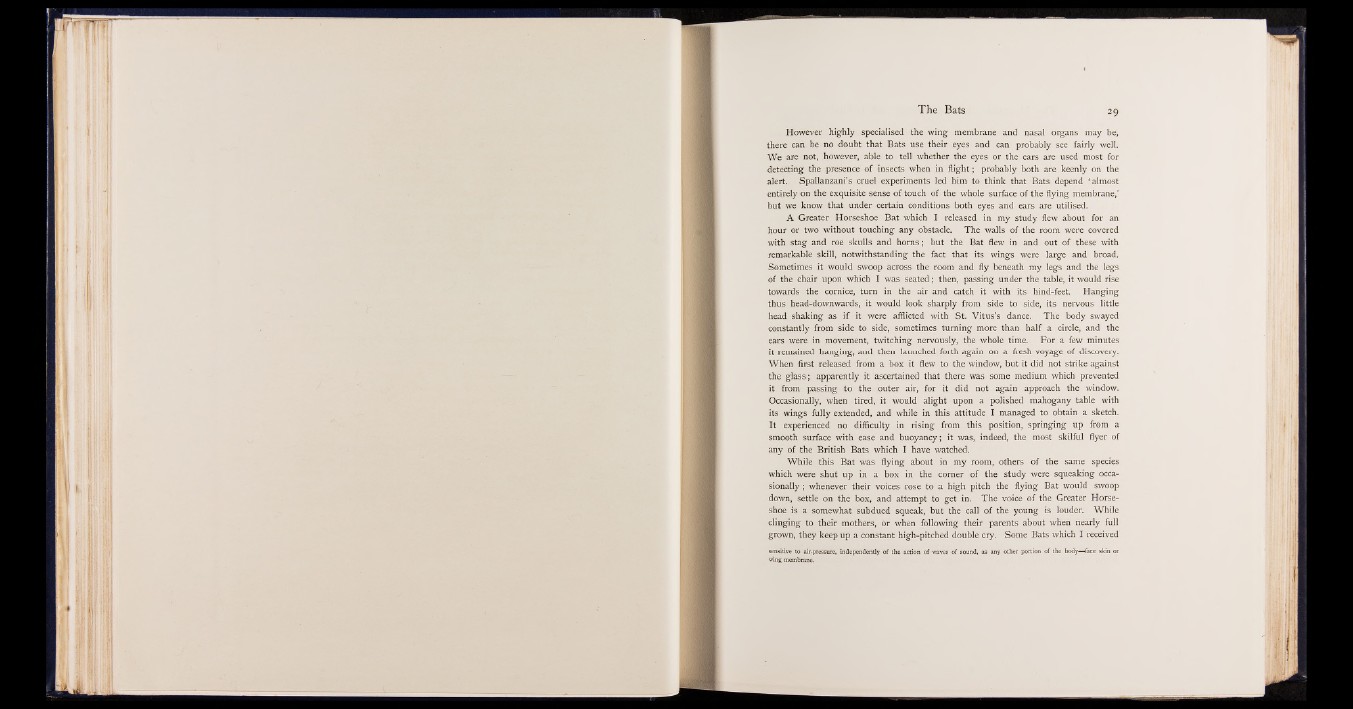
However highly specialised the wing membrane and nasal organs may be,
there can be no doubt that Bats use their .eyes and can probably see fairly well.
We are not, however, able to tell whether the eyes or the ears are used most for
detecting the presence of insects when in flight; probably both are keenly on the
alert. Spallanzani’s cruel experiments led him to think that Bats depend ‘ almost
entirely on the exquisite sense of touch of the whole surface of the flying membrane,’
but we know that under certain conditions both eyes and ears are utilised.
A Greater Horseshoe Bat which I released in my study flew about for an
hour or two without touching any obstacle. The walls of the room were covered
with stag and roe skulls and horns; but the Bat flew in and out of these with
remarkable skill, notwithstanding the fact that its wings were large and broad.
Sometimes it would swoop across the room and fly beneath my legs and the legs
of the chair upon which I was seated; then, passing under the table, it would rise
towards the cornice, turn in the air and catch it with its hind-feet. Hanging
thus head-downwards, it would look sharply from side to side, its nervous little
head shaking as if it were afflicted with St. Vitus’s dance. The body swayed
constantly from side to side, sometimes turning more than half a circle, and the
ears were in movement, twitching nervously, the whole time. For a few minutes
it remained hanging, and then launched forth again on a fresh voyage of discovery.
When first released from a box it flew to the window, but it did not strike against
the glass; apparently it ascertained that there was some medium which prevented
it from passing to the outer air, for it did not again approach the window.
Occasionally, when tired, it would alight upon a polished mahogany table with
its wings fully extended, and while in this attitude I managed to obtain a sketch.
It experienced no difficulty in rising from this position, springing up from a
smooth surface with ease and buoyancy; it was, indeed, the most skilful flyer of
any of the British Bats which I have watched.
While this Bat was flying about in my room, others of the same species
which were shut up in a box in the corner of the study were squeaking occasionally
; whenever their voices rose to a high pitch the flying Bat would swoop
down, settle on the box, and attempt to get in. The voice of the Greater Horseshoe
is a somewhat subdued squeak, but the call of the young is louder. While
clinging to their mothers, or when following their parents about when nearly full
grown, they keep up a constant high-pitched double cry. Some Bats which I received
sensitive to air-pressure, independently of the action of waves of sound, as any other portion of the body— face skin or
wing membrane.